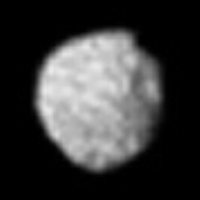Puck (moon)
 |
|
| Discovery | |
|---|---|
| Discovered by | Stephen P. Synnott / Voyager 2 |
| Discovery date | December 30, 1985 |
| Designations | |
| Adjectives | Puckian |
| Orbital characteristics | |
|
Mean orbit radius
|
86,004.444 ± 0.064 km |
| Eccentricity | 0.00012 ± 0.000061 |
| 0.76183287 ± 0.000000014 d | |
|
Average orbital speed
|
8.21 km/s |
| Inclination | 0.31921 ± 0.021° (to Uranus's equator) |
| Satellite of | Uranus |
| Physical characteristics | |
|
Mean radius
|
81 ± 2 km |
| ~82,400 km² | |
| Volume | ~2,225,000 km³ |
| Mass | ~2.9 × 1018kg |
|
Mean density
|
~1.3 g/cm³ (assumed) |
| 0.028 m/s2 | |
| 0.069 km/s | |
| synchronous | |
| zero | |
| Albedo |
|
| Temperature | ~64 K |
| 20.5 | |
Puck (/ˈpʌk/ PUK) is an inner moon of Uranus. It was discovered in December 1985 by the Voyager 2 spacecraft. The name Puck follows the convention of naming Uranus's moons after characters from Shakespeare. The orbit of Puck lies between the rings of Uranus and the first of Uranus's large moons, Miranda. Puck is approximately spherical in shape and has diameter of about 162 km. It has a dark, heavily cratered surface, which shows spectral signs of water ice.
Puck—the largest inner moon of Uranus—was discovered from the images taken by Voyager 2 on 30 December 1985. It was given the temporary designation S/1985 U 1.
The moon was later named after the character Puck who appears in Shakespeare's A Midsummer Night's Dream, a little sprite who travels around the globe at night with the fairies. In Celtic mythology and English folklore, a Puck is a mischievous sprite, imagined as an evil demon by Christians.
It is also designated Uranus XV.
Puck is the largest small inner moon of Uranus, which orbits inside the orbit of Miranda. It is intermediate in size between Portia (the second-largest inner moon) and Miranda (the smallest of the five large classical moons). Puck's orbit is located between the rings of Uranus and Miranda. Little is known about Puck aside from its orbit, radius of about 81 km, and geometric albedo in visible light of approximately 0.11.
...
Wikipedia
